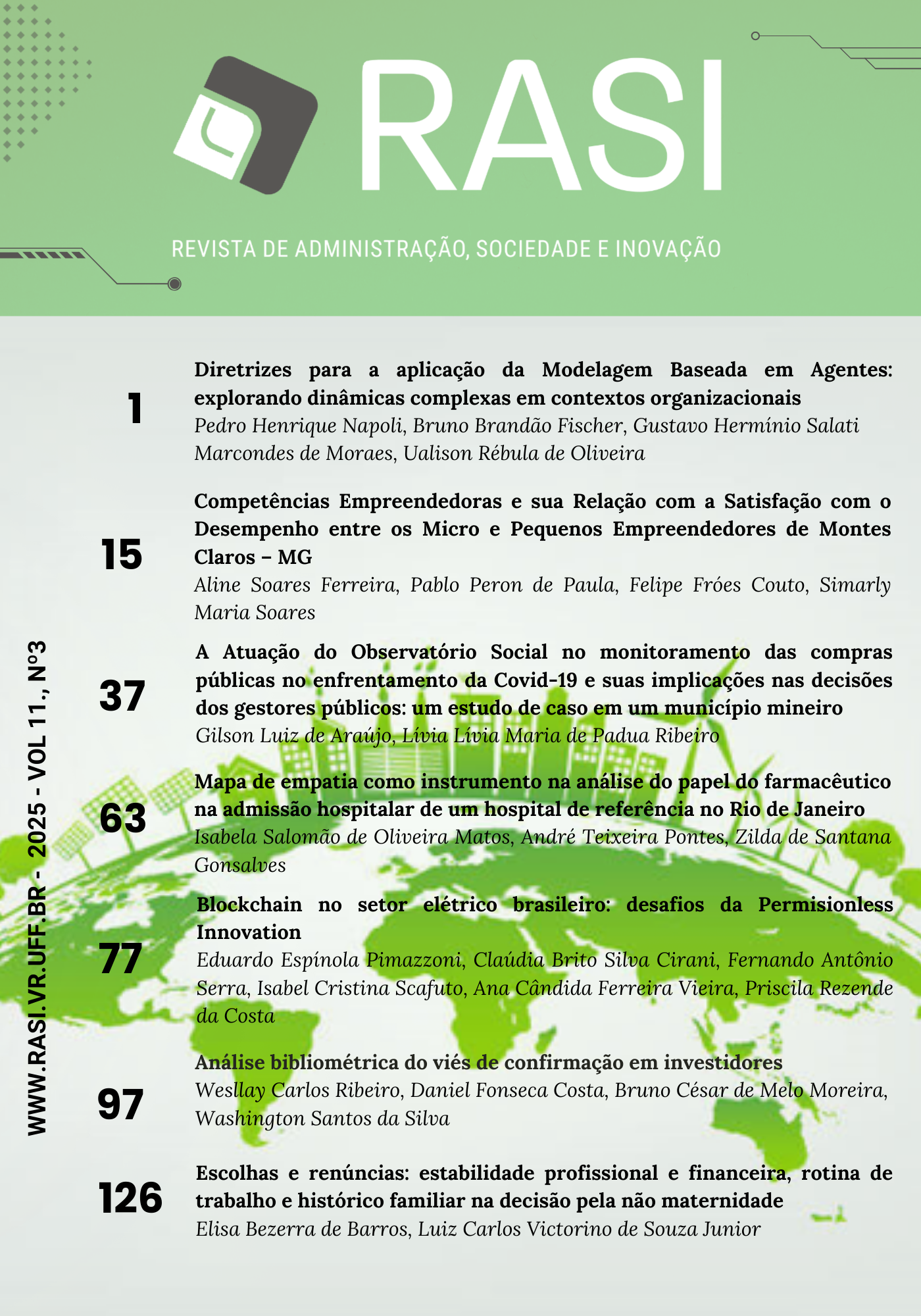Empathy map as an instrument in the analysis of the role of the pharmacist in hospital admission in a reference hospital in Rio de Janeiro
DOI:
https://doi.org/10.20401/rasi.11.3.998Keywords:
Gestão em Saúde, Empatia, Design Thinking, Serviço farmacêuticoAbstract
One of the patient's first contacts when admitted to hospitals is through the admission process, which consists of a series of steps that authorize the patient's entry into the hospital environment. Because it is a process that involves various professions and diferente hospital departments, there is a higher risk of experiencing failures. In this context, practicing empathy in the corporate environment can contribute to the development of more committed and satisfied employees in their activities, resulting in a greater value delivery to the patient. This study aimed to analyze the role of the pharmacist in the hospital admission process of a reference hospital in Rio de Janeiro using the empathy map from the Design Thinking philosophy. A cross-sectional study with a descriptive and qualitative-quantitative approach was conducted. Professionals involved in the admission process were invited for interviews with their informed consent, and subsequently, an empathy map was created summarizing the main needs and perceptions of the team. The use of the empathy map aided in better understanding the challenges faced by pharmacists and the healthcare team's perception of pharmaceutical services.
Downloads
References
Abugroun, A., et al. (2025). Development of an emergency department triage tool to predict admission or discharge for older adults. International Journal of Emergency Medicine, 18(1).
Andersson, T., Linnéeusson, G., Holméen, M., & Kjellsdotter, A. (2023). Nurturing innovative culture in a healthcare organisation: Lessons from a Swedish case study. Journal of Health Organization and Management, 37(9), 17-33.
Andreazza, R. S., et al. (2011). Causes of drug-related problems in the emergency room of a hospital in southern Brazil. Gaceta Sanitaria, 25(6), 501-506.
Avezum, Á., et al. (2024). An intersectoral approach to hypertension care: Solutions for improving blood pressure control in São Paulo, Brazil. American Journal of Hypertension, 37(5), 366–378. https://doi.org/10.1093/ajh/hpae005
Bardin, L. (2011). Análise de conteúdo. São Paulo: Edições, 70.
Bonato, V. L. (2011). Gestão de qualidade em saúde: Melhorando assistência ao cliente. O Mundo da Saúde, 2011(3), 319–331.
Businessolver. (2017). Workplace empathy monitor executive summary. Disponível em: https://info.businessolver.com/hubfs/workplace-empathy-monitor-executivesummary.pdf. Acesso em: 17 set. 2023.
Byers, K., Gee, A., & Anwar, M. (2024). Developing pharmacy leaders: A design thinking approach to navigate the leadership crisis in pharmacy. Canadian Pharmacists Journal / Revue des Pharmaciens du Canada, 157(3), 104-106.
Cançado, P., Moura, E. P., & Peixoto, J. M. (2021). O efeito do mapa da empatia em saúde no comportamento empático médico percebido pelo paciente. Saúde e Pesquisa, 14(2), 261–270.
Carroll, M. (2014). Shoot for the moon! The mentors and the middle schoolers explore the intersection of design thinking and STEM. Journal of Pre-College Engineering Education Research (J-PEER), 4(1), 14–30.
Chhabra, P. T., et al. (2012). Medication reconciliation during the transition to and from long-term care settings: A systematic review. Research in Social and Administrative Pharmacy, 8, 60-75.
Coelho, A. S. (2018). A empatia como instrumento de gestão. Intervozes: Trabalho, Saúde, Cultura, 3(2), 20–40.
Del-valle Quintana, L., Sichieri, K., & Secoli, S. (2025). Design Thinking and its use to promote patient safety: a scoping review. Journal of Healthcare Quality Research, 40(4).
Gonçalves, L. S., et al. (2023). Uso do mapa de empatia na produção tecnológica para prevenção de quedas hospitalares. Journal of Health Informatics, 15(Especial).
Gonsalves, Z. S., et al. (2025). Ações da preceptoria no ensino-aprendizagem de residentes farmacêuticos na admissão hospitalar: um relato de experiência. Interface (Botucatu), 29(e230615).
Hellström, L. M., Bondesson, A., Höglund, P., & Eriksson, T. (2012). Errors in medication history at hospital admission: Prevalence and predicting factors. BMC Clinical Pharmacology, 12(9), 1-9.
Heskett, J. (2002). Toothpicks and logos: Design in everyday life. OUP Oxford.
Hussain, A. S. M., et al. (2025). Medication reconciliation: impact of an educational intervention on the knowledge, attitude and practices of healthcare professionals – a prospective quasi-experimental study in a Saudi referral hospital. Journal of Health, Population and Nutrition, 44(1).
Karloopia, J. J., & Agrawal, R. (2024). Identifying and modeling barriers to design thinking implementation in healthcare sector: An ISM-MICMAC approach. Journal of Health Organization and Management, 38(4), 1-23.
Knez, L., Suskovic, S., Rezonja, R., Laaksonen, R., & Mrhar, A. (2011). The need for medication reconciliation: A cross-sectional observational study in adult patients. Respiratory Medicine, 105(1), S60-S66.
Lanazi, A. S. et al. (2022). Medication reconciliation on discharge in a tertiary care Riyadh hospital: an observational study. PLoS ONE, 17(3), e0265042.
Lindenmeyer, L. P., Goulart, V. P., & Hegele, V. (2013). Reconciliação medicamentosa como estratégia para a segurança do paciente oncológico: Resultados de um estudo piloto. Revista Brasileira de Farmácia Hospitalar e Serviços de Saúde, 4(4), 51–55.
Liu, Y. T. (1996). Is designing one search or two? A model of design thinking involving symbolism and connectionism. Design Studies, 17(4), 435–449.
Noblat, A. C. B., et al. (2011). Prevalência de admissão hospitalar por reação adversa a medicamentos em Salvador, BA. Revista da Associação Médica Brasileira, 57(1), 42-45.
Norliyana, M. D., Aris, N. H., & Halim, N. D. A. (2024). Design and development research (DDR) approach in designing design thinking chemistry module to empower students’ innovation competencies. Journal of Advanced Research in Applied Sciences and Engineering Technology, 44(1), 55–68. https://doi.org/10.37934/araset.44.1.5568
Oliveira, M., Zancul, E., & Fleury, A. L. (2021). Design thinking as an approach for innovation in healthcare: Systematic review and research avenues. BMJ Innovations, 7(2), 491-498. https://doi.org/10.1136/bmjinnov-2020-000428
Peixoto, J. M., & Moura, E. P. (2020). Mapa da empatia em saúde: Elaboração de um instrumento para o desenvolvimento da empatia. Revista Brasileira de Educação Médica, 44(1), 1–8.
Perassolo, L., Bajerski, E. J., & Staudt, K. J. (2025). Intervenção farmacêutica: uma contribuição para segurança do paciente hospitalar. Revista Interdisciplinar em Ciências da Saúde e Biológicas, 9(1), 43–57.
Pfaffenbach, G., Carvalho, O. M., & Bergsten-Mendes, G. (2002). Reações adversas a medicamentos como determinantes da admissão hospitalar. Revista da Associação Médica Brasileira, 48(3), 237-241.
Plattner, H., Leifer, L., & Meinel, C. (Eds.). (2011). Design thinking: Understand - improve - apply: Understanding innovation. Springer.
Rahemi, Z., D'Avolio, D., Dunphy, L. M., & Rivera, A. (2018). Shifting management in healthcare: An integrative review of design thinking. Nursing Management, 49(12), 30–37.
Ribeiro, A., Ricci, D. K., De Oliveira, M., Ferreira, A. P., & Schettino, G. (2021). Farmácia clínica: transformação do profissional farmacêutico. Revista Científica do UBM, 46, 112-123.
Rodrigues, I. T., & Moreira, J. (2017). A relação profissionais de saúde - usuários do SUS: Problematizando o termo “ajuda”. Revista Polis Psique, 7(3), 43–60.
Sandars, J., & Goh, P.-S. (2020). Design thinking in medical education: The key features and practical application. Journal of Medical Education and Curricular Development, 7, 238–242.
Sebire, N. J., et al. (2025). The future hospital in global health systems: the future hospital as an entity. International Journal of Health Planning and Management, 40(3), 730–740.
Sousa, L. U. R., et al. (2021). Mapa da empatia em saúde como instrumento de reflexão em cenário de ensino não assistencial. Revista Brasileira de Educação Médica, 45(4), e195.
Spalla, L. R., & Castilho, S. R. (2016). Medication reconciliation as a strategy for preventing medication errors. Brazilian Journal of Pharmaceutical Sciences, 52(1), 143–150.
Varallo, F. R. (2010). Internações hospitalares por reações adversas a medicamentos (RAM) em um hospital de ensino (Dissertação de Mestrado). Faculdade de Ciências Farmacêuticas, Universidade Paulista “Júlio de Mesquita Filho”, Araraquara.
Downloads
Published
Issue
Section
License
Copyright (c) 2025 Review of Administration, Society and Innovation

This work is licensed under a Creative Commons Attribution 4.0 International License.
RASI, in accordance with Law No. 9,610 of February 19, 1998, which amends, updates and consolidates Brazilian copyright law and makes other provisions, adopts the following conditions of the Copyright Assignment:
1. RASI maintains, with the transfer of copyrights, the possession of rights over the content published;
2. The author retains his moral rights of the content, including the right to be identified as the author whenever the content is published;
3. Despite the attribution of copyright, the author retains the right to reuse the material in future collections of his own work without encumbrance. The acknowledgments of the previous publication in the RASI are the only requirements in such cases;
4. The author may make photocopies of the content, or distribute it by electronic mail or fax, provided that they are intended for their own classes and for the purpose of meeting research objectives, provided that: (a) such copies are not resold and (b) reference to the original source of the publication and the name of the RASI are clearly indicated on all copies made of the document.











